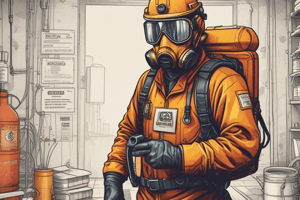Podcast
Questions and Answers
Qual es le definition del 'exposition acute'?
Qual es le definition del 'exposition acute'?
- A gradual increase in exposure to toxic chemicals.
- Exposure to a hazardous substance over a long period.
- Immediate exposure to a hazardous substance for a short duration. (correct)
- Exposure to a benign substance with no harmful effects.
Qual es un exemplo de 'waste contaminato'?
Qual es un exemplo de 'waste contaminato'?
- Biological waste from healthcare facilities. (correct)
- Paper records disposed of in a recycling bin.
- Food waste from a cafeteria.
- Unused pharmaceuticals in a refrigerator.
Qual es le differentia inter 'rischio fisic' e 'rischio sanitari'?
Qual es le differentia inter 'rischio fisic' e 'rischio sanitari'?
- Health hazards can be avoided by using personal protective equipment, while physical hazards cannot.
- Physical hazards refer to dangers from instruments, while health hazards are related to biological agents. (correct)
- There is no significant difference; both describe potential dangers in a workplace.
- Physical hazards are only environmental whereas health hazards are solely biological.
Qual signo indica un 'hypoglycemia'?
Qual signo indica un 'hypoglycemia'?
In le context de 'cardiopulmonary resuscitation (CPR)', qual es le sequente passo post-apertura del vias aereas?
In le context de 'cardiopulmonary resuscitation (CPR)', qual es le sequente passo post-apertura del vias aereas?
What is the primary purpose of a Safety Data Sheet (SDS)?
What is the primary purpose of a Safety Data Sheet (SDS)?
Which term refers to waste that is capable of causing infection or disease?
Which term refers to waste that is capable of causing infection or disease?
What are Korotkoff sounds used to determine during blood pressure measurements?
What are Korotkoff sounds used to determine during blood pressure measurements?
Which condition is characterized by a severe allergic reaction that can lead to respiratory distress?
Which condition is characterized by a severe allergic reaction that can lead to respiratory distress?
Which of the following conditions describes low blood pressure?
Which of the following conditions describes low blood pressure?
Flashcards
Acute exposure
Acute exposure
Short-term contact with a hazard.
Chronic exposure
Chronic exposure
Long-term contact with a hazard.
Hazardous waste
Hazardous waste
Waste materials that pose a risk to health or the environment.
Safety Data Sheet (SDS)
Safety Data Sheet (SDS)
Signup and view all the flashcards
Health hazard
Health hazard
Signup and view all the flashcards
Chemical Inventory
Chemical Inventory
Signup and view all the flashcards
Hazard Communication Standard (HCS)
Hazard Communication Standard (HCS)
Signup and view all the flashcards
Infectious Waste
Infectious Waste
Signup and view all the flashcards
Label Elements
Label Elements
Signup and view all the flashcards
Study Notes
Chemical Inventory
- A list of chemicals present in a workplace or facility.
Acute Exposure
- Short-term exposure to a harmful substance.
Chronic Exposure
- Long-term exposure to a harmful substance.
Contaminated Waste
- Waste that has been exposed to hazardous materials.
Hazard Classification
- Categorization of hazardous materials based on their potential dangers.
Hazard Communication Standard (HCS)
- Standard for communicating hazard information about chemicals.
Hazardous Waste
- Waste that is dangerous to human health or the environment.
Health Hazard
- Potential for injury or adverse health effects.
Infectious Waste
- Waste that could transmit disease.
Label Elements
- Required information on a hazardous chemical container.
Physical Hazard
- Potential for property damage or injury from physical characteristics.
Regulated Waste
- Waste that is subject to specific government regulations.
Safety Data Sheet (SDS)
- Document containing information on a hazardous material's properties and safety handling procedures.
Toxic Chemicals
- Chemicals that can cause severe health problems.
Toxic Waste
- Waste containing toxic chemicals.
Antiretraction Device
- A device to prevent a dental device from being pulled back.
Biofilm
- A microbial community on a surface.
Dental Unit Waterline (DUWL)
- Water system in a dental unit.
Immunocompromised
- Individuals with weakened immune systems.
Legionella
- A bacteria that can cause a serious lung infection.
Self-Contained Water Reservoir
- A water reservoir separate from the main water system.
Arrhythmia
- Irregular heartbeat.
Blood Pressure (BP)
- Force of blood against artery walls.
Carotid
- Major artery in the neck.
Diastolic
- Pressure in arteries during relaxation of the heart.
Electrocardiogram (ECG)
- Recording of the electrical activity of the heart.
Korotkoff Sounds
- Sounds heard during blood pressure measurement.
Oximetry
- Measurement of oxygen saturation in the blood.
Palpate
- Examine by feeling with the hands.
Pulse
- Rhythmic expansion of an artery.
Respiration
- Breathing.
Sphygmomanometer
- Instrument for measuring blood pressure.
Stethoscope
- Instrument for listening to internal body sounds.
Systolic
- Pressure in arteries during contraction of the heart.
Thermometer
- Instrument for measuring temperature.
Acute
- Sudden or rapid onset.
Allergy
- Abnormal immune system response to a substance.
Anaphylaxis
- Severe allergic reaction.
Angina
- Chest pain caused by reduced blood flow to the heart.
Antibodies
- Proteins produced by the immune system to fight infections.
Antigen
- Substance that triggers an immune response.
Aspiration
- Inhalation of foreign material into the lungs.
Cardiopulmonary Resuscitation (CPR)
- Emergency life-saving procedure.
Erythema
- Skin redness.
Hyperglycemia
- High blood sugar levels.
Hypersensitivity
- Excessive immune response.
Hyperventilation
- Rapid and deep breathing.
Hypoglycemia
- Low blood sugar levels.
Hypotension
- Low blood pressure.
Syncope
- Loss of consciousness.
Studying That Suits You
Use AI to generate personalized quizzes and flashcards to suit your learning preferences.




